高中英语状语从句用法详解
状语从句的引导词及用法详解
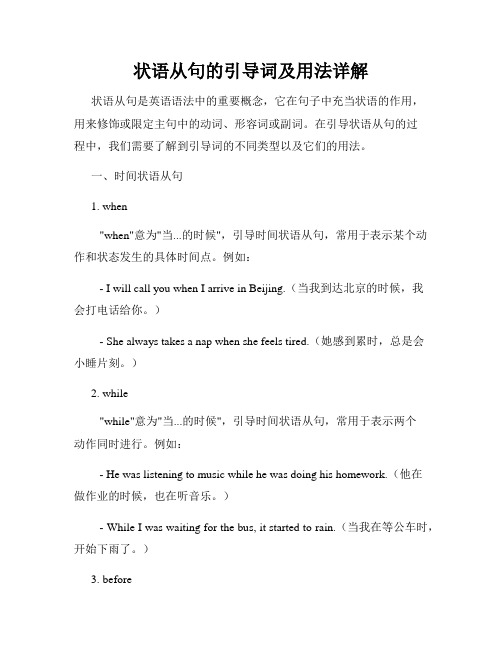
状语从句的引导词及用法详解状语从句是英语语法中的重要概念,它在句子中充当状语的作用,用来修饰或限定主句中的动词、形容词或副词。
在引导状语从句的过程中,我们需要了解到引导词的不同类型以及它们的用法。
一、时间状语从句1. when"when"意为"当...的时候",引导时间状语从句,常用于表示某个动作和状态发生的具体时间点。
例如:- I will call you when I arrive in Beijing.(当我到达北京的时候,我会打电话给你。
)- She always takes a nap when she feels tired.(她感到累时,总是会小睡片刻。
)2. while"while"意为"当...的时候",引导时间状语从句,常用于表示两个动作同时进行。
例如:- He was listening to music while he was doing his homework.(他在做作业的时候,也在听音乐。
)- While I was waiting for the bus, it started to rain.(当我在等公车时,开始下雨了。
)3. before"before"意为"在...之前",引导时间状语从句,常用于表示在某个动作之前发生的动作。
例如:- Please finish your homework before you go out to play.(在你出去玩之前,请完成你的作业。
)- Susan had already left the office before I arrived.(在我到达之前,苏珊已经离开了办公室。
)二、原因状语从句1. because"because"意为"因为",引导原因状语从句,常用于表示某个动作或状态发生的原因。
状语从句的种类与用法详解

状语从句的种类与用法详解状语从句是英语语法中的重要部分,它在句子中充当状语,用于修饰、限定主句的动作、状态或其他方面。
状语从句有多种种类和用法,下面将对其进行详细解析。
1. 时间状语从句时间状语从句用于表示主句中的动作发生的时间,具体用法如下:- 当主句谓语动词表示延续性动作时,使用while引导的时间状语从句。
例如:While I was studying for the exam, my phone rang.(当我正在备考时,我的手机响了。
)- 当主句谓语动词表示瞬时性动作时,使用when或as引导的时间状语从句。
例如:When I arrived at the station, the train had already left.(当我到达车站时,火车已经开走了。
)2. 地点状语从句地点状语从句用于表示主句中的动作发生的地点,具体用法如下:- 使用where引导的地点状语从句。
例如:I will meet her where we had our first date.(我会在我们第一次约会的地方见她。
)3. 原因状语从句原因状语从句用于表示主句中的动作发生的原因,具体用法如下:- 使用because或since引导的原因状语从句。
例如:He couldn't come to the party because he had to work overtime.(他不能来参加聚会,因为他得加班。
)- 使用as引导的原因状语从句,强调两个动作同时发生。
例如:As the sun set, the sky turned orange.(太阳下山时,天空变成橙色。
)4. 条件状语从句条件状语从句用于表示主句中的动作发生的条件,具体用法如下:- 使用if或unless引导的条件状语从句。
例如:If it rains tomorrow, we will stay indoors.(如果明天下雨,我们将呆在室内。
高考高中英语长难句分析详解 时间状语从句

高考高中英语长难句分析详解时间状语从句Your lights will come on the instant you enter the door along with your favorite music or TV programmes, and you will find your dinner already prepared for you.语法/单词/短语1.并列主从复合句,由连词and连接。
2.第一个分句采用的是一般将来时态,含有一个由the instant 引导的时间状语从句,意思为一……就,你一进门你的灯就会打开。
3.instant: n.瞬间;片刻;某一时刻,adj.立即的;立刻的;速食的;即食的;速溶的;方便的4.除此之外,它还有一个特殊用法,The moment 和The instant /The minute一样,可以引导时间状语从句,意思相当于as soon as。
5.或者我们也可以从定语从句的角度去理解,instant是瞬间,片刻的意思,它可以作为一个时间副词在从句中做状语,那么关系副词要用when,但句子中并没有when,而且when是不可以省略的,所以这里不是这样的用法。
但是instant做先行词是可以的,关系副词用when:the instant when……意思是当……的时候Your lights will come on the instant when you enter the door。
6.本句中还有一个介词短语along with 和……一起,就是说和灯一起亮的,还有你喜欢的音乐或者电视节目。
7.第二个分句采用的仍然是一般将来时态,主谓宾补的结构,过去分词prepared作dinner的补足语,表被动。
Mr. Smith will not be able to attend the meeting this Saturday, because he will be doing something important.语法/单词/短语1.本句主要想体现:一般将来进行时与将来时的对比使用,是由because连接的主从复合句。
专题讲解--状语从句

专题讲解-------并列句和状语从句【考点点击】:1.引导状语从句的从属连词的用法2.表示条件、时间、原因等意义的状语从句的用法。
3.并列句的选词并列句一、定义:用并列连词连接起来的两个或两个以上的简单句叫作并列句。
其构成为:简单句+并列连词+简单句二、并列句的种类1.表示顺承、并列、递进关系的连词及并列句and “和‟both…and….”“···和···两个都”,as well as “也”;not only…but also….”“不但···而且···”等。
My mother bought me a dress, and I like it very much.2.表示转折或对比关系的连词及并列句。
but “但是”. yet “然而”;while “而”.Lucy likes red while Luly likes white.3.表示选择关系的连词及并列句:either……or………” “要么….要么”连接主语时,采用就近原则。
Or “或者”,还可以表示“否则”。
Study hard, or you …ll fail the exam.4.表示因果关系的连词及并列句:so 意为“所以,因此”,表示因果关系。
Ann was ill so she didn‟t ho to shool.for:意为“因为”,也表示因果关系。
I have to stay up late, for I have lots of homework to do.5. and 和or用于否定句中的区别(1)当列举成分是主语,又在否定词之前时,用and 连接,当列举成分在否定词之后时,用or 构成完全否定。
Lucy and Lily can‟t speak Chinese. I can‟t sing or dance.(2) 在否定句中,如果所连接的两部分都有否定词,那么用and, 而不用or.There is no water and no air on the moon.状语从句一、定义:在句子中作状语的从句叫做状语从句。
状语从句的种类及用法详解

状语从句的种类及用法详解状语从句是一个从句,它在句中充当状语的角色。
状语从句通常用于修饰主句的动词、形容词、副词或整个句子。
状语从句可以用来表示时间、原因、条件、目的、方式、结果等不同的内容。
下面将详细介绍状语从句的种类及用法。
一、时间状语从句时间状语从句用来表示一个动作、事件或状态发生的时间。
常见的引导词有when(当...时候)、while(当...的时候)、before(在...之前)、after(在...之后)、since(自从)、as soon as(一...就)、until (直到)、as long as(只要)等。
例如:1. When I arrived at the airport, the flight had already left.(当我到达机场时,航班已经起飞了。
)2. She will not go to bed until she finishes her homework.(她不会睡觉直到她完成作业。
)二、原因状语从句原因状语从句用来表示主句中的动作或状态发生的原因。
常见的引导词有because(因为)、since(因为)、as(因为)、due to(因为)、owing to(因为)、for the reason that(因为)等。
例如:1. She didn't attend the meeting because she was sick.(她没有参加会议,因为她生病了。
)2. Since it is raining heavily outside, we should stay at home.(由于外面下大雨,我们应该呆在家里。
)三、条件状语从句条件状语从句用来表示主句中的动作或状态发生的条件。
常见的引导词有if(如果)、unless(除非)、provided that(倘若)、as long as (只要)、on condition that(在...条件下)等。
高中英语状语从句用法详解

状语从句用法详解在主从复合句中修饰主句的动词、形容词、副词等的从句叫状语从句。
一般可分为:时间状语从句、地点状语从句、原因状语从句、目的状语从句、结果状语从句、条件状语从句、让步状语从句、比较状语从句、方式状语从句。
I 时间状语从句:起时间状语作用的从句。
(时间状语从句位置灵活,可以在句首,也可在句末)常用来引导时间状语从句的引导词有:when, while, as, after, before,until/till, since, as soon as, immediately, the moment, every time, whenever等。
1.when, while, as1) when“当......的时候”,表示主从句的谓语动作同时发生或先后紧接着发生。
I was very happy when I heard from you.收到你的信时我非常高兴。
When you deal with them, you should be cautious.跟他们打交道时,你应该谨慎。
when引导时间状语从句中的谓语动词可以用非延续性动词,也可用延续性动词。
When I was young, I went to town myself.当我还年轻时,我自己独自去城里。
(延续性动词)When I lived in country, I used to carry some water for him.我住在农村时,常常为他担水。
(延续性动词)When he received the letter, he'll tell us.当他接到信后,他会告诉我们的。
(非延续性动词)When the fire broke out, all the students were sleeping soundly.火灾发生时,所有的学生正在熟睡。
(非延续性动词)注意:当when引导的时间状语从句为系表结构,而且其主语和主句的主语一致,其表语又是一个名词时,就可以用由as引导的省略句来代替when引导的从句。
状语从句用法详解
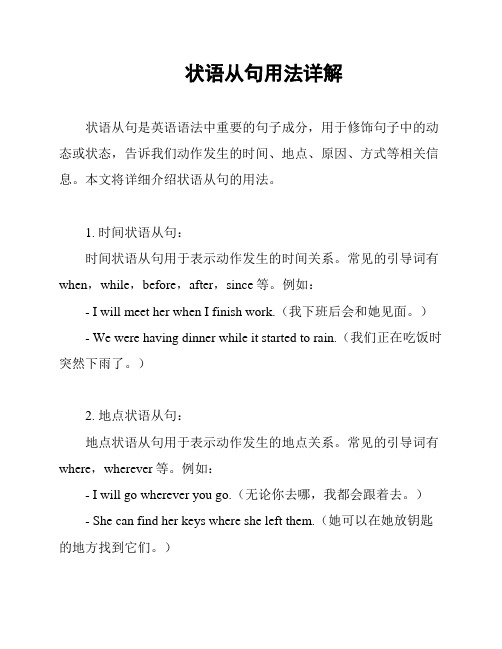
状语从句用法详解状语从句是英语语法中重要的句子成分,用于修饰句子中的动态或状态,告诉我们动作发生的时间、地点、原因、方式等相关信息。
本文将详细介绍状语从句的用法。
1. 时间状语从句:时间状语从句用于表示动作发生的时间关系。
常见的引导词有when,while,before,after,since等。
例如:- I will meet her when I finish work.(我下班后会和她见面。
)- We were having dinner while it started to rain.(我们正在吃饭时突然下雨了。
)2. 地点状语从句:地点状语从句用于表示动作发生的地点关系。
常见的引导词有where,wherever等。
例如:- I will go wherever you go.(无论你去哪,我都会跟着去。
)- She can find her keys where she left them.(她可以在她放钥匙的地方找到它们。
)3. 原因状语从句:原因状语从句用于表示某个动作或状态的原因。
常见的引导词有because,since,as等。
例如:- As it was getting late, we decided to leave.(由于时间很晚,我们决定离开。
)4. 方式状语从句:方式状语从句用于表示某个动作或状态的方式。
常见的引导词有as,like,as if等。
例如:- She danced as if nobody was watching.(她像没人看着一样跳舞。
)- He treats me like a princess.(他像对待公主一样对待我。
)需要注意的是,在使用状语从句时,需要注意主句和从句之间的时态和语序的一致性。
此外,状语从句通常位于主句之前或之后,但也可以放在主句的中间。
总结:状语从句是用于修饰句子中动态或状态的从句,用于表示时间、地点、原因、方式等相关信息。
英语八类状语从句的用法归纳

英语八类状语从句的用法归纳一、概说状语从句即指在主从复合句用作状语的从句。
按照其意义,状语从句可分为时间状语从句、地点状语从句、原因状语从句、目的状语从句、结果状语从句、条件状语从句、让步状语从句等。
状语从句是高中英语学习中的一个语法重点,也是历年高考重点考查的内容之一。
学习状语从句主要应注意引导状语从句的从属连词的用法与区别,以及从属连词在一定的语言环境中的意义与用法。
二、时间状语从句1.引导时间状语从句的从属连词很多,常见的有before, after, when, while, as, since, till, until, as soon as 等。
2.表示“当…时候”的while, when, as 的用法区别是:while从句中的谓语动词必须是延续性动词;表示带有规律性的“每当”或当主、从句谓语动词的动作发生有先后时,只能用when;当表示“一边…一边…”或“随着”时,只能用as。
另外,用于此义的as 所引导的时间状语从句谓语只能是动作动词,不能是状态动词。
如下面一道高考题的答案是B 而不能是A:“I’m going to the post office.” “_____ you’re there, can you get me some stamps?”A. AsB. WhileC. BecauseD. If3.until 在肯定句中通常只连用延续性动词,表示相应动作结束的时间;在否定句中通常连用非延续性动词,表示相应动作开始的时间,意为“直到…才”。
如:He waited until she was about to leave. 他等着一直到她准备离开。
I did not begin to work till he had gone. 他走了后我才开始工作。
4.表示“一…就”除用as soon as 外,还可用the minute, the second, the instant, immediately, directly, i nstantly, no sooner…t han, hardly…w hen 等。
状语从句讲解及习题附答案

状语从句讲解及习题附答案(一)状语从句概述定义状语从句用作状语,是起副词作用的句子。
位置状语从句可以放在主句之前,也可以放在主句之后,时间、条件、原因和让步状语从句放在句首时需要用逗号和主句隔开。
分类根据其作用可以分为时间、地点、原因、条件、目的、让步、方式和比较等状语从句。
作用它可以修饰谓语、非谓语动词、定语、状语和整个句子。
(二)状语从句详解1. 时间状语从句引导词用法示例when 意为“当…的时候”。
When引导从句的谓语动词可以是延续性动词,也可以是瞬间动词。
并且when有时表示“就在那时”A liar is not believed when he speaks the truth.说谎者讲真话时也没有人相信。
When he arrives, I’ll call you. When you laugh and smile, your body relaxes.while 意为“在…的时候,在…的同时”。
While引导从句的谓语动词必须是延续性的,发生时间较长,并强调主句和从句的动作同时发生(或者相对应)。
While有时还可以表示对比。
While I was standing at the window, I saw several boys running along the street.While John was watching TV, his wife was cooking.as 意为“一边…一边…”。
As引导的动作是延续性的,发生时间较短,一般用于主句和从句动作同时发生;as也可以强调一前一后。
The writer was angry as he was travelling on a train to London because someone had invaded his “space”.He smiled as he stood up.after 意为“在…之后”。
高中英语状语从句用法详解
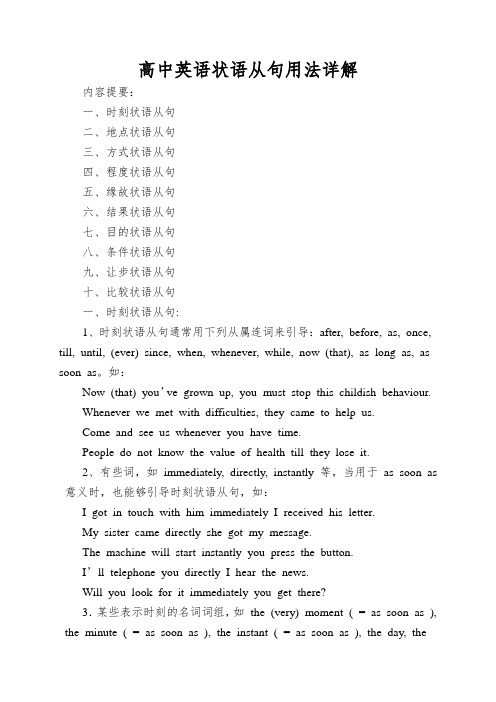
高中英语状语从句用法详解内容提要:一、时刻状语从句二、地点状语从句三、方式状语从句四、程度状语从句五、缘故状语从句六、结果状语从句七、目的状语从句八、条件状语从句九、让步状语从句十、比较状语从句一、时刻状语从句:1、时刻状语从句通常用下列从属连词来引导:after, before, as, once, till, until, (ever) since, when, whenever, while, now (that), as long as, as soon as。
如:Now (that) you’ve grown up, you must stop this childish behaviour.Whenever we met with difficulties, they came to help us.Come and see us whenever you have time.People do not know the value of health till they lose it.2、有些词,如immediately, directly, instantly 等,当用于as soon as 意义时,也能够引导时刻状语从句,如:I got in touch with him immediately I received his letter.My sister came directly she got my message.The machine will start instantly you press the button.I’ll telephone you directly I hear the news.Will you look for it immediately you get there?3.某些表示时刻的名词词组,如the (very) moment ( = as soon as ), the minute ( = as soon as ), the instant ( = as soon as ), the day, theyear, the morning, every time, each time, next time, the first time 等,也能够引导时刻状语从句,如:I’ll tell you about it the moment you come.I started the instant I heard the report.The instant she saw him she knew he was her brother.Every time I catch a cold, I have pain in my back.I’m going to see him next time he comes to Shenzhen.He left Europe the year World WarⅡbroke out.He had impressed me that way the first time I met him.I started the very moment I got your letter.I’ll tell him the minute (that) he gets here.4.有些关联从属连词,如no sooner …than / hardly …when / sca rcely …when / barely …when 等,也能引导时刻状语从句。
英语重点词汇since引导时间状语从句的用法详解

千里之行,始于足下。
英语重点词汇since引导时间状语从句的用法详解“Since”作为时间状语从句的引导词,常用于表示一个动作或状态开始的时间点。
以下是其用法的详细解释:1. “Since + 时间点/时间短语”这种用法表示一个具体的时间点或短暂的时间段,常用于过去的时间。
例如:- I have been living in this city since 2005.我从2005年开始就在这个城市生活。
- Jack has known Mary since they were in elementary school.杰克和玛丽从他们上小学的时候就认识。
2. “Since + 过去的时间点/事件”这种用法表示从过去某个时间点或某个事件发生之后的时间段。
例如: - She has been very sick since last week.自从上周以来,她一直很生病。
- We haven't seen each other since I moved to another city.自从我搬到另一个城市以后,我们就再也没见过面。
3. “Since + 过去完成时句子”当主句和从句的动作发生的时间点相同时,通常使用过去完成时的句子来引导时间状语从句。
例如:- I hadn't seen her since she had moved to Canada.自从她搬到加拿大以后,我就没见过她。
- They had been friends since they had met in college.自从他们在大学里相遇以来,他们就是朋友了。
第1页/共2页锲而不舍,金石可镂。
需要注意的是,由于“since”引导的时间状语从句中使用的是过去时态或过去完成时态,所以主句常常使用现在完成时态来表示从过去到现在的情况。
例如:- I have known him since we were children.我从我们还是孩子的时候就认识他了。
状语从句详解

状语从句详解状语从句是复句中的一种从句,用来修饰动词、形容词、副词或整个句子。
它起到进一步说明、补充或限制主句的作用。
本文将详细解析状语从句的定义、分类、用法及注意事项。
一、状语从句的定义状语从句是一个从属分句,由连词引导,在主从句之间建立一种从属关系。
它通常修饰动词、形容词、副词或整个句子,用来表示时间、条件、原因、目的、方式、程度、比较等等。
通过引导词的不同,状语从句可以分为多种类型。
二、状语从句的分类1. 时间状语从句时间状语从句用来表示动作发生的时间,在主句中起到修饰的作用。
时间状语从句常用的引导词有:when(当)、while(当...时)、before (在...之前)、after(在...之后)、as(当...的时候)等等。
例如:- I will call you when I arrive home.(我到家后会给你打电话。
)- They went to bed after they finished their homework.(他们做完作业后就上床睡觉了。
)2. 条件状语从句条件状语从句用来表示主句发生的条件,在主句中起到修饰的作用。
条件状语从句常用的引导词有:if(如果)、unless(除非)、provided that(只要)、as long as(只要)等等。
例如:- If it rains, we will stay at home.(如果下雨,我们将待在家里。
)- You can go out unless it is too cold.(除非天气太冷,你可以出去。
)3. 原因状语从句原因状语从句用来表示主句发生的原因,在主句中起到修饰的作用。
原因状语从句常用的引导词有:because(因为)、since(因为)、as (因为)、for(因为)等等。
例如:- She didn't come to the party because she was sick.(她没有来参加聚会,因为她生病了。
高一英语教案:必修一 状语从句专项讲解

高考英语状语从句专项讲解一、考点分析状语从句主要考点在语法填空、翻译和作文。
二、专题详解状语从句梳理知识点1:分类语从句可以分为以下九种:1、时间状语从句2、地点状语从句3、原因状语从句4、目的状语从句5、结果状语从句6、条件状语从句7、方式状语从句8、让步状语从句9、比较状语从句知识点2:具体用法1) 时间状语从句:as soon as Hardly/scarcely had…whenNo sooner had …than….the moment.. the instant…the second…immediately directly…instantly…①As soon as I arrive in Shanghai, I’ll writeto you.我一到上海就给你写信。
② Hardly (scarcely) had I got homewhen it began to rain.我刚一到家就下雨了。
③No sooner had we got to the stationthan the train left.我们刚到车站,火车就走了。
④We had just begun the moment wewere told to stop.我们刚开始就被叫停。
⑤I felt cheerful immediately I heard thesong.我一听到这首歌就感到很愉快。
①hardly…when和nosooner…than的意义相当于as soon as,但只表示过去发生的事情,主句为过去完成时,从句为过去时,如hardly或no sooner位于句首时语气强,而且主句的谓语要用部分倒装。
②名词短语连词:“一……就……”主句+ the moment…从句主句+the instant…从句主句+the second…从句③ 副词短语连词:主句+ immediately +从句主句+ directly +从句主句+ instantly+从句every time =each time last time…next time…the first time ①Every time I traveled by boat, I gotseasick.我每次乘船都晕船。
状语从句 大集合 详解加例句 一目了然

主句一般过去时+从句一般过去时 at that time: 短暂动作时 使用一般过去时态 主句一般过去时+从句过去完成时 主句过去完成时+从句一般过去时 主句一般过去时+从句过去进行时 during that time,延续动 主句过去进行时+从句一般过去时 作使用过去进行时 (可在从句中加suddenly一词) when 主句一般将来时+从句一般现在时(从句用一般现在时表将来) 表示从句 主句一般将来时+从句现在完成时 动作先发 (从句用现在完成时表一个将要发生的动作,为了强调,在从句 生 表达时间 动作结束了之后,主句动作才开始发生,此时从句动作一般都是 是将来 要持续一段时间的) 表示主句 先发生 表示时间 是现在 whenever while 主句将来完成时+从句一般现在时 主句将来进行时+从句一般现在时, 主从句都用一般现在时,表示一般动作的when引导的从句往往是 说明一般情况,阐明一个道理,常出现在名言警句,或格言中。 表示“无论如何”,相当于when的强调形式 during that time,从句的谓语动词通常是延续动词 还有另外三个意思:表示条件的“只要”,表示对比的“然而”,表示让步的“尽管 ” 延续动词 延续动词+until(连词)+从句的短暂动词 延续动词+until(介词)+ 表示时间点的名词短语 Smile whenever you pick up the phone, for the caller will be able to notice it. The doorbell rang while we all watching TV. Until I came back, he was waiting for me at my home. I will be away from my office until next Tuesday. 都表达从句动作先发生, I started my dinner when he left. 意义相差不大,句型可转 I started my dinner when he had left. 换 若要表示主句动作先发 I had started my dinner when he 生,则主句使用过去完成 left. 时。 The doorbell rang when I was telephoning . I was telephoning when the bell rang. I'll tell him about it when he comes back. The winner will be declared when every competitor has finished the course. The performer will already have played the music when we get there. The performer will be playing the music when we get there.
高考英语状语从句和动词时态详解及练习
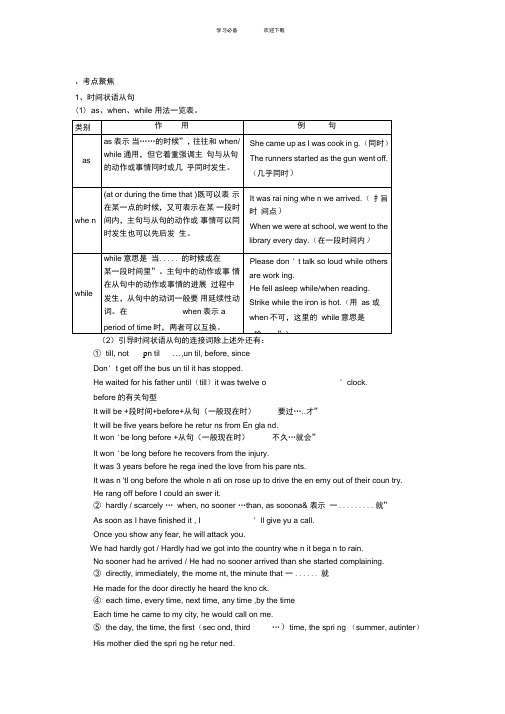
、考点聚焦1、时间状语从句(1) as、when、while 用法一览表。
(2)引导时间状语从句的连接词除上述外还有:①till, not p n til …,un til, before, sinceDon' t get off the bus un til it has stopped.He waited for his father until(till)it was twelve o ' clock.before的有关句型It will be +段时间+before+从句(一般现在时)要过…..才”It will be five years before he retur ns from En gla nd.It won 'be long before +从句(一般现在时)不久…就会”It won 'be long before he recovers from the injury.It was 3 years before he rega ined the love from his pare nts.It was n 'tl ong before the whole n ati on rose up to drive the en emy out of their coun try.He rang off before I could an swer it.②hardly / scarcely … when, no sooner …than, as sooona& 表示一......... 就”As soon as I have finished it , I ' ll give yu a call.Once you show any fear, he will attack you.We had hardly got / Hardly had we got into the country whe n it bega n to rain.No sooner had he arrived / He had no sooner arrived than she started complaining.③directly, immediately, the mome nt, the minute that 一...... 就He made for the door directly he heard the kno ck.④each time, every time, next time, any time ,by the timeEach time he came to my city, he would call on me.⑤the day, the time, the first(sec ond, third …)time, the spri ng (summer, autinter)His mother died the spri ng he retur ned.注意:表示未来情况,主句用将来时,从句用现在时。
条件状语从句与时间状语从句的区别与用法详解
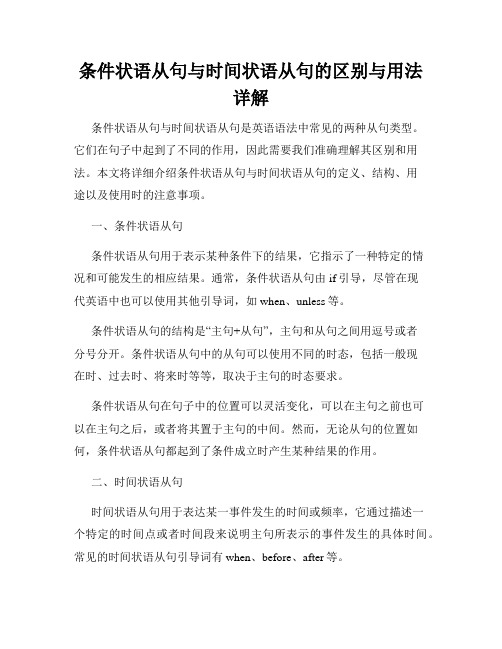
条件状语从句与时间状语从句的区别与用法详解条件状语从句与时间状语从句是英语语法中常见的两种从句类型。
它们在句子中起到了不同的作用,因此需要我们准确理解其区别和用法。
本文将详细介绍条件状语从句与时间状语从句的定义、结构、用途以及使用时的注意事项。
一、条件状语从句条件状语从句用于表示某种条件下的结果,它指示了一种特定的情况和可能发生的相应结果。
通常,条件状语从句由if引导,尽管在现代英语中也可以使用其他引导词,如when、unless等。
条件状语从句的结构是“主句+从句”,主句和从句之间用逗号或者分号分开。
条件状语从句中的从句可以使用不同的时态,包括一般现在时、过去时、将来时等等,取决于主句的时态要求。
条件状语从句在句子中的位置可以灵活变化,可以在主句之前也可以在主句之后,或者将其置于主句的中间。
然而,无论从句的位置如何,条件状语从句都起到了条件成立时产生某种结果的作用。
二、时间状语从句时间状语从句用于表达某一事件发生的时间或频率,它通过描述一个特定的时间点或者时间段来说明主句所表示的事件发生的具体时间。
常见的时间状语从句引导词有when、before、after等。
时间状语从句的结构也是“主句+从句”,从句可以使用不同的时态来表示不同的时间关系。
比如,当主句表示的事件发生在过去时,时间状语从句可以使用过去的时态,如一般过去时、过去完成时等等。
与条件状语从句不同的是,时间状语从句通常紧跟在主句之后,并用逗号或者分号与主句分开。
时间状语从句直接修饰主句,用来说明主句的时间情景。
三、条件状语从句与时间状语从句的区别虽然条件状语从句和时间状语从句在结构上很相似,但是它们却有着明显的不同之处。
首先,条件状语从句与时间状语从句的功能不同。
条件状语从句用于表示某种条件下的结果,它描述了一种情况和可能发生的结果。
而时间状语从句用于描述事件的时间或频率,它强调了主句所表示的事件发生的具体时间。
其次,条件状语从句和时间状语从句在词性上也有区别。
状语从句用法详解
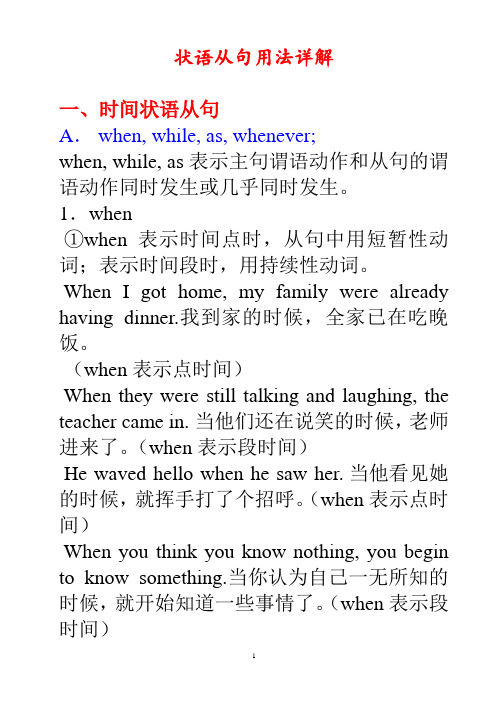
状语从句用法详解一、时间状语从句A. when, while, as, whenever;when, while, as表示主句谓语动作和从句的谓语动作同时发生或几乎同时发生。
1.when①when表示时间点时,从句中用短暂性动词;表示时间段时,用持续性动词。
When I got home, my family were already having dinner.我到家的时候,全家已在吃晚饭。
(when表示点时间)When they were still talking and laughing, the teacher came in. 当他们还在说笑的时候,老师进来了。
(when表示段时间)He waved hello when he saw her. 当他看见她的时候,就挥手打了个招呼。
(when表示点时间)When you think you know nothing, you begin to know something.当你认为自己一无所知的时候,就开始知道一些事情了。
(when表示段时间)【注意】当when意思是正当……时候(and at that moment)时,when只能跟在前一分句之后。
He was about to go to bed when the doorbell rang. 他正要上床,忽然门铃响了。
They were watching the World Cup when suddenly the lights went out. 他们正看着世界杯比赛,突然灯灭了。
They had just arrived home when it began to rain. 他们刚到家,天就开始下雨了。
②有时when表示虽然,尽管的含义,相当于although或since。
He walks when he might take a taxi. 尽管可以打的,但他还是步行。
考点33 目的状语从句(含答案解析)

A.In order toB.In order not to
C.So as toD.So as not to
【答案】B
【解析】
【详解】句意:为了不迟到,她抄近路穿过田野。表示“为了不……”可用in order not to或so as not to,so as not to不可用于句首,A和C表达有误,故选B。
He has to earn so lots of muney so that he can buy his children nice food and clothes.
他必须赚很多钱才能给他的孩子提供好的饮食和衣服。
4. such...that...
在such...that...句型中,such修饰名词,意思是"如此……以至于……",such...that...引导四种不同的句子结构。
他们都是很好的学生,老师喜欢他们。
(3)such+(形容词)+不可数名词+that从句
It was such fime weather yesterday that we went swimming.
昨天天气很好,我们去游泳了。
(4)one(no,any,all,many,some,several等)+such+可数名词+that从句
(1)常用句型:主语+谓语+so+adj./adv.+that从句
The boy ran so fast that I couldn’t catch him.
这个男孩跑得太快了以至于我追不上他。
(2)so+形容词+ a(n)+单数名词+that从句
英语语法与词汇详解 状语从句之让步状语从句

英语语法与词汇详解状语从句之让步状语从句1、常用的让步状语从句连接词有although,though,even though 和while2、通过句子体会这些连接词的用法(1)I used to read a lot although/though I don't get much time for books now.[虽然现在我没有太多时间读书,但在过去我读了很多书。
](2)She couldn't resist the idea of admiring superheroines(女强人)even though she had resolved to believe no more such modern fairy tales.[虽然她决心不再相信这些现代神话故事,但她却情不自禁对女强人充满了敬仰。
](3)While I did well in class,I was a poor performer at games.[虽然课堂上我表现很好,但在比赛时我表现却很差。
](4)Even though John doesn't speak Japanese,he should still pay a visit.[虽然约翰不讲日语,他也应该去日本看看。
]3、whether...or(not)为“无论……还是……”之意,用于加强主句的语气,表示强调(1)Whether you go to a launderette(自动洗衣店)or do your washing at home,the routine is the same.[无论你是去洗衣店,还是自己在家洗衣服,程序都是一样的。
](2)l get an electrician to check all my electrical appliances every autumn,whether they are giving trouble or not.[每年秋天我都会让电工把所有的电器检查一遍,无论它们有无问题。
方式状语从句与结果状语从句的区别与用法详解

方式状语从句与结果状语从句的区别与用法详解方式状语从句与结果状语从句是英语语法中常见的两种状语从句,它们分别用于描述行为的方式和结果。
本文将详细解析方式状语从句与结果状语从句的区别与用法。
1. 方式状语从句方式状语从句用于描述行为的方式、方式状况或条件。
常用的方式状语从句引导词有"as"和"as if",例如:She walked slowly as if she were exhausted.她走得很慢,仿佛非常疲惫。
In order to achieve success, you have to work hard as if there were no tomorrow.为了成功,你必须努力工作,就像没有明天一样。
从以上例句可以看出,方式状语从句通常与动词或形容词连用,用以描述主语的行为方式或状态。
2. 结果状语从句结果状语从句用于表达一个行为或事件发生后所产生的结果。
结果状语从句常常由"so"、"so that"、"such...that"等引导,例如:He was so tired that he fell asleep immediately.他非常疲劳,以至于立刻睡着了。
She spoke loudly so that everyone could hear her.她大声说话,以便每个人都能听到。
结果状语从句一般与情态动词、形容词或副词连用,常用于表达因果关系。
3. 方式状语从句与结果状语从句的区别方式状语从句与结果状语从句的区别主要在于其表达的内容和所起作用。
方式状语从句主要用于描述一个动作或行为发生的方式、方式状况或条件。
它回答了“怎样做”的问句,给出了主语行动的方式或状态。
结果状语从句则用于描述一个动作或行为后所产生的结果,它回答了“发生了什么”的问句,给出了主语行动所带来的后果。
- 1、下载文档前请自行甄别文档内容的完整性,平台不提供额外的编辑、内容补充、找答案等附加服务。
- 2、"仅部分预览"的文档,不可在线预览部分如存在完整性等问题,可反馈申请退款(可完整预览的文档不适用该条件!)。
- 3、如文档侵犯您的权益,请联系客服反馈,我们会尽快为您处理(人工客服工作时间:9:00-18:30)。
状语从句用法详解内容提要:一、时间状语从句二、地点状语从句三、方式状语从句四、程度状语从句五、原因状语从句六、结果状语从句七、目的状语从句八、条件状语从句九、让步状语从句十、比较状语从句一、时间状语从句:1、时间状语从句通常用下列从属连词来引导:after, before, as, once, till, until, (ever) since, when, whenever, while, now (that), as long as, as soon as。
如:Now (that)you’ve gr own up, you must stop this childish behaviour. Whenever we met with difficulties, they came to help us.Come and see us whenever you have time.People do not know the value of health till they lose it.2、有些词,如immediately, directly, instantly 等,当用于as soon as 意义时,也可以引导时间状语从句,如:I got in touch with him immediately I received his letter.My sister came directly she got my message.The machine will start instantly you press the button.I’ll t elephone you directly I hear the news.Will you look for it immediately you get there?3.某些表示时间的名词词组,如the (very) moment ( = as soon as ), the minute ( = as soon as ), the instant ( = as soon as ), the day, the year, the morning, every time, each time, next time, the first time 等,也可以引导时间状语从句,如:I’ll tell you about it the moment you come.I started the instant I heard the report.The instant she saw him she knew he was her brother.Every time I catch a cold, I have pain in my back.I’m going to see him next time he comes to Shenzhen.He left Europe the year World WarⅡbroke out.He had impressed me that way the first time I met him.I started the very moment I got your letter.I’ll tell him the minute (that) he gets here.4.有些关联从属连词,如no sooner …than / hardly …when / scarcely …when / barely …when 等,也能引导时间状语从句。
△如果把no sooner, hardly, scarcely, barely 置于句首,它所连带的这部分就要倒装,如:She had no sooner heard the news than she fainted.= No sooner had she heard the news than she fainted.They had hardly started to work when the trouble began.= Hardly had they started to work when the trouble began.He had scarcely entered the room when the phone rang.= Scarcely had he entered the room when the phone rang.二、地点状语从句:1、地点状语从句常用where, wherever 来引导,如:We will stay where you stay. (where = in the place in which; where 既连接主句与从句,又在从句中作副词修饰谓语stay。
)I found my books where I left them.Wherever he happens to be, John can make himself at home.He will work wherever the people need him.Let me go wherever (= to any place to which) they like (to go).2、有时,- where 构成的复合词也可以引导地点状语从句,如:Everywhere they went, they were kindly received / warmly welcomed. We’ll go anywhere the Party directs us.三、方式状语从句:1、方式状语从句通常由as, as if, as though 来引导,如:You must do the exercises as I show you.Please do exactly as your doctor says.It looks as if it might snow / is going to snow.He acted as if / though nothing had happened.He walked as if he was / were drunk.Mary was behaving as though she h adn’t grown up.2、在非正式文体或口语中,也可用the way (that) (= as = in the way in which), how, like 等来引导,如:Jean doesn’t do it the way I do.She is doing her work the way I like it done.You can do the job how you like.The landlord was watching him like(= just as) a cat watches a mouse. Do you make bread like you make cakes?like 作连词的用法补充说明:1). Conjunction (informal)(非正式):in the same way that; as同…一样,如People who change countries like they change clothes.换国籍像换衣服一样的人。
2). as though; as if 好像,如同I felt like I'd been kicked by a camel. 我觉得好像被骆驼踢了似的。
四、程度状语从句:程度状语从句可用to such an extent that … / to such a degree that … , to the degree/ extent that, in so far as (“在…的范围内”)等来引导,如:The temperature rose to such an extent that the firemen had to leave theburning building.The temperature lowered to such a degree that the water froze.试比较:The temperature rose so high that the firemen had to leave the burning building.The temperature lowered so much that the water froze.从以上例句可以看出,程度状语从句往往也表示达到某种程度时所引出的结果,所以程度状语从句和结果状语从句在意义上有相通之处。
At that time politicians were not known to the degree that they are today. 那时政治家们并不像今天这样为人所知晓。
I'll help you in so far as I can. 我会尽我所能帮助你。
五、原因状语从句:1、引导原因状语从句最常用的连词是because, since, 和as,所引导的从句可以放在主句之前,也可放在主句之后。
其中because 语势最强,since 次之,as 又次之。
△because通常表示说话人认为这种理由或原因是听话人所不知道的,全句强调的重点在原因上,不在主句表示的结果上。
回答why 提出的问题时,只能用because;在强调句型中也只能用because从句,不能用since, as等,如:Because I can’t se e very well, I have to sit near the front.It was because he was ill that he didn’t go wit h us.It was because he was ill that he didn’t come.△since 和as 引导的句子,重点在主句的内容,其原因或理由在说话人看来已很明显,或已为听话人所熟悉,since 和as 只是一种附带的说明原因,不是对原因进行强调,如:As he is working hard, he is likely to succeed.Since he can’t answer the question, you’d bet ter ask someone else.As / Since he was not at home, I spoke to his brother.Since you insist, I will reconsider the matter.As he was in a hurry, he left his bag at home.△for 是并列连词,它引导的句子只能后置。
